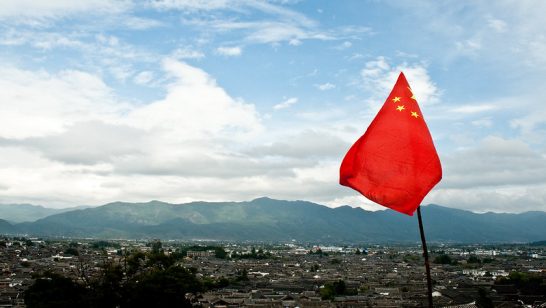
This piece is part of a new ELN series on the P5 Process exploring national viewpoints from the five nuclear-weapon states ahead of the NPT Review Conference.
The United States’ engagement in the P5 Process looks distinct from that of other members. Washington recognises the value of the forum for frank discussion between the P5—or as Assistant Secretary Christopher Ford suggests, the “N5”—on their special responsibilities under the Non-Proliferation Treaty (NPT), and has joined the other P5 states in reaffirming its commitment to the NPT. Yet while they maintain that P5 progress is achievable, US officials are wary of the lack of intersessional developments and encourage caution around equating meeting with substantive progress.
Most distinct, though, the US perspective of the P5 Process is inextricably linked to its perception of the global security environment. In nearly every recent statement about the Process, US officials cite concerns over “various conditions in the international security environment that make progress on disarmament so frustratingly slow.” These conditions range from threats posed by North Korea’s nuclear programme to “Russian and Chinese nuclear build-ups,” the latter receiving particular attention in P5 settings. This focus on the security environment significantly informs Washington’s approach to the P5 Process, affecting its contributions to and prospects for the future of the forum. It also presents a possible way ahead—a forward-looking leadership role for the United States in the P5 Process.
Current contributions
Over the 11-year history of the P5 Process, the United States has remained an active player, contributing to dialogues and discussions as well as hosting conferences in both 2012 and 2016. The 2012 meeting, in particular, showcased US efforts to promote transparency between the P5, although recent decisions not to declassify stockpile numbers have led some to accuse the Trump Administration of taking backward steps on these transparency efforts.
More specifically, the United States is meant to lead on non-proliferation and arms control discussions. These topics align well with Washington’s focus on the security environment. Non-proliferation, however, receives significant attention in other forums and does not appear a primary focus area of the P5 Process, apart from some references to Iran and North Korea’s nuclear activities in P5 statements over the years. Some have suggested that including non-proliferation in the P5’s purview is more of a box-ticking exercise meant to cement its connection to the NPT and serve as an easy display of P5 unity. While arms control does receive significant US attention, the current arms control regime is in disarray and its future is far from certain. Thus substantive P5 outputs on Washington’s lead topic areas are lacking.
Perhaps the most recent US contribution to the goals of the P5 Process has been its launch of the Creating an Environment for Nuclear Disarmament (CEND) initiative. While tangential to the P5 Process, CEND has become a focal point of US disarmament efforts. Indeed, its distinction from the Process and NPT more broadly is partly why the United States places such value in the forum, allowing for the inclusion of nuclear-armed states outside of the NPT. Nevertheless, Washington maintains that CEND contributes to the goals of the NPT—and specifically, the P5’s collective Article VI obligation—because of its focus on the international security environment. Further progress on disarmament hinges on improvements in security conditions. CEND fosters frank and constructive dialogue to address key challenges and work towards cooperative solutions. As stated by Ford, “an ‘environment’-focused global disarmament discourse aimed at the amelioration of security challenges… is likely the only approach with a chance of providing us all a viable path to disarmament.”
“Next-generation arms control”
US officials have cited some areas of interest for future P5 work—including risk reduction, strengthened efforts to discourage withdrawal from the NPT, and non-traditional partnerships for expanding access to peaceful uses, as related to each pillar of the NPT. Their discussion of the challenges posed by Russia and China to the security environment, however, sheds light on a topic more often referenced by Washington in P5 discussions about the way ahead: arms control. To be clear, the United States views this as a topic requiring discussions separate from the P5 Process. Officials regularly caution against the Process becoming an excuse to avoid substantive discussions in bilateral (or trilateral) contexts. Yet mounting concerns around an emerging arms race have brought tensions between Washington, Moscow, and Beijing to the forefront of the P5 forum and on public display, for instance, during the civil society portion of the 2020 P5 conference.
The current arms control climate is precarious. The United States withdrew from the Joint Comprehensive Plan of Action (JCPOA) in May 2018 and Intermediate-Range Nuclear Forces (INF) Treaty in August 2019 after voicing concerns over Iran’s adherence to the agreement and years of Russian treaty violations. Speculation now looms over US intentions to withdraw from the Open Skies Treaty, but perhaps most attention focuses on the extension of the US-Russian New Strategic Arms Reduction Treaty (START).
The United States has not ruled out extending New START for an additional five years. Yet it has linked its hesitation not only to concerns over Russia’s military build-ups but also China’s strategic developments. To the former, officials reference developments of new strategic delivery systems and a large stockpile of non-strategic nuclear weapons. To the latter, they cite a rapid expansion of tactical and strategic nuclear capabilities. In response, the Trump Administration has prioritised a trilateral agenda for “next-generation arms control,” strategic dialogue focused on preventing a three-way arms race.
This has met significant resistance, with Russia expressing a willingness to extend New START as-is, and China claiming at the P5 conference that the push for trilateral arms control is a US “ploy” to complicate New START extension. China continues to refuse nuclear reduction discussions in the same context as Russia and the United States given the vast disparities in the states’ arsenal sizes.
A way forward
So how should the United States proceed? The P5 Process presents a significant opportunity, especially as we look to the next NPT Review Cycle. Washington should recommit itself to the Process by adopting a forward-looking leadership role. While unlikely that the United States would take the lead on an initiative similar to China’s glossary work, for instance, it should contribute more thoughtfully and cooperatively in areas related to its international security concerns. This could include, for instance, working alongside France to advance risk reduction conversations. Amidst a series of recommendations for the Process more broadly, King’s College London and the European Leadership Network suggest that the P5 should establish a working group on strategic risk reduction and crisis stability, to include specific discussion around the impact of emerging technologies. The United States could focus in particular on this last point, adopting a “sub-work stream” leadership role. This would align well with US concerns over the international security environment as emerging technologies will surely play an important and potentially destabilising role in the future—including the potential to significantly affect future arms control discussions.
Precisely because of conditions in the international security environment, maintaining an open forum for dialogue between the P5 is important now more than ever, and presents an opportunity for substantive developments where bilateral and trilateral efforts currently lack. Taking on a more defined P5 Process leadership role—and perhaps most likely doing so by leading a “sub-work stream”—would allow the US to help steer this progress and address those security concerns it deems most relevant. By shifting attention in the P5 Process to leading forward-looking discussions, the United States would not only reaffirm its serious commitment to and recognition of the value of the Process, but also its efforts to effectively address challenging conditions in the international security environment.
The opinions articulated above represent the views of the author(s) and do not necessarily reflect the position of the European Leadership Network or any of its members. The ELN’s aim is to encourage debates that will help develop Europe’s capacity to address the pressing foreign, defence, and security policy challenges of our time.
Image: Flickr, Pranav Bhatt



